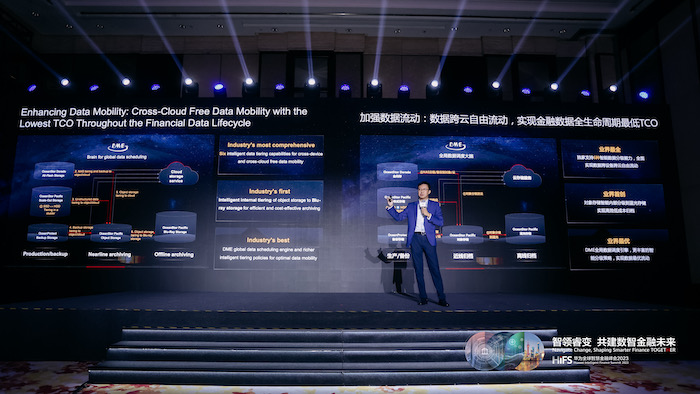Huawei launches F2F2X data infrastructure architecture to help FSI build and manage modern data centres
The Huawei Intelligent Finance Summit 2023 saw the launch of Huawei’s new data centre infrastructure architecture for the financial services industry (FSI) – F2F2X (Flash-to-Flash-to-Anything).
The architecture is a response to today’s data storage and management challenges and forms a reliable data foundation to help cope with data proliferation, an increasing number of apps, and the need for resilience around that. Indeed, data is a bank’s core asset. Data stability, security, and data computing power all have an impact on the service that customers receive and the productivity of a bank.
There are three major challenges in particular for the existing data infrastructure of banks. Data proliferation, its storage, performance and having the right resilience capabilities.
Therefore, robust management is a must if banks are to successfully deal with.
Indeed, new business models and services including customisation, smart contracts, digital assets, and metaverse banking all create more data to store and manage. The IDC estimates that by 2025, the amount of data generated by banks worldwide will reach 48.6 zettabytes, with a compound annual growth rate (CAGR) of 26.2%. 80% of new data will be unstructured production data and structured data is likely to increase tenfold.
Keeping data safe is another challenge; the average ransomware attack costs its victim an average of $7.8 million and they are happening more and more.
Data resilience is the third issue. If there was a network-side protection failure, a firm would need to be able to act quickly to prevent data from being encrypted, and provide prompt attack warnings. If that cannot be done quickly enough and data ends up encrypted or worse, the entire data centre is “contaminated”, then a firm need the ability to retain a complete and clean data copy for rapid recovery of the service system.
The advent of the multi-cloud era also adds to the challenges of data management and mobility – an estimated 89% of enterprises will soon become multi-cloud. This will give rise to the need for data management for app containerisation. In addition, efficient data flow between different apps and media will become a new challenge for banks’ data management.
All of this has implications for storage capacity, performance, and energy efficiency – existing systems are already under strain.
The very first bank in the Republic of Türkiye to offer customers credit card services, Yapı Kredi had over 12.9 million credit cards issued by the end of 2021. Other payments solutions included traditional point of sale (PoS) services and online applications, but also support quick response (QR) code and contactless payments over mobile devices, as well as innovative payments from inside the car.
At the beginning of 2022, it was focusing on upping card usage, as well as PoS customers over digital channels as well as enhancing the overall customer experience. There was also increased demand for contactless payments. Getting in the way of all this was the need to upgrade storage; during service peak hours, workloads were soaring, with more and more users logging in to the bank’s app, causing legacy information and communications (ICT) infrastructure to strain, unable to scale effectively to meet demand.
In particular, the bank was looking for a secondary storage node to boost the resiliency, availability, and overall performance of its payment systems. Any solution also needed to be immune to downtime to avoid any fall in service quality.
The bank chose the Huawei OceanStor Dorado solution, a high-end all-flash storage system that delivers industry-leading performance. This system features intelligent acceleration, designed to meet the demands of core enterprise services. It also sets unprecedented standards for industry reliability, tolerating the failure of seven out of eight controllers.
Indeed, the new Huawei architecture solves these issues by providing F2F2X architecture thus giving all-flash primary and backup storage and diversified archive storage. It has four central components that should, in combination, give firms the power to realise the potential of their data.
Data acceleration+
Core technologies such as decoupled storage, compute and multi-controller and multi-active architecture accelerate data processing in financial scale-out new core and financial data warehouse scenarios. The architecture also provides all-flash primary storage and backup, and have 30% higher performance than the industry’s next best.
Data resilience+
The Huawei-proprietary machine learning (ML) algorithm has the industry’s highest detection rate (99.9%) and forms the last line of defence for data resilience with a four-layer storage ransomware protection solution.
Data green+
An industry leading storage capacity that delivers a superior energy consumption ratio to meet the low carbon needs and targets of the industry. Indeed, by using flash disks, the solution provides customers with the system-level energy-saving solution. The high-density design of the main storage and the deduplication and compression ratio technology on the backup storage help customers provide a 50-year data saving duration and reduce the time required for database rollback by five times as much as that required by tapes.
Data management+
The Huawei full lifecycle DME significantly improves management efficiency by realising data retrieval in seconds from ten billion files, multi-dimensional intelligent analytics of global files, quick identification of the distribution of hot and cold data, and intelligent tiering and deletion of data.

Michael Fan, vice president of global data centre marketing and solution sales dept, Huawei Enterprise BG, said: “Huawei’s data infrastructure products and solutions have served more than 1,300 financial institutions worldwide. Our customers’ need for 4+ data centres drives us to innovate non-stop. We will continue to invest in a more reliable, more efficient, and greener’ data foundation for the financial industry to address business challenges in the intelligent era.”
All in all, the launch and adoption of this data infrastructure solution should help banks to more effectively manage their data – thus leaving them free to leverage it to maximum effect for their various business lines as well as to use it strategically for business growth and strategic expansion. The direction of travel for the industry as a whole is clear – without robust data management banks will fall down in being able to perform the most basic of tasks, much less be able to effectively manage and use data both for themselves and clients, solutions that take the data pain away are crucial for this rapidly changing and evolving industry.
The launch was a part of the Huawei Intelligent Finance Summit 2023 which was held on 7-8 June in Shanghai, China. Under the theme “Navigate Change, Shaping Smart Finance TOGETHER”, the two-day summit saw Huawei’s key strategies unveiled as well as several announcements and strategic memorandums of understanding (MOU) signed in the finance sector. During the event industry leaders gathered and shared their insights on digital trends for the future of finance and successful cases.
For more details, please visit Huawei Intelligent Finance.
Sponsored by Huawei











































